Al Ain, UAE is an oasis city 140Kms from Dubai, featuring ancient archaeological sites like Hili Archaeological Park, which dates back to the 3rd millennium BC. The Sheikh Zayed Palace Museum showcases traditional Emirati life, while the Al Ain National Museum offers a 7500-year history of UAE culture and traditions. Visitors can also explore the Al Nassma Camel Farm, where they can feed and pet camels, including those producing camel milk chocolate, a unique taste experience in the region.
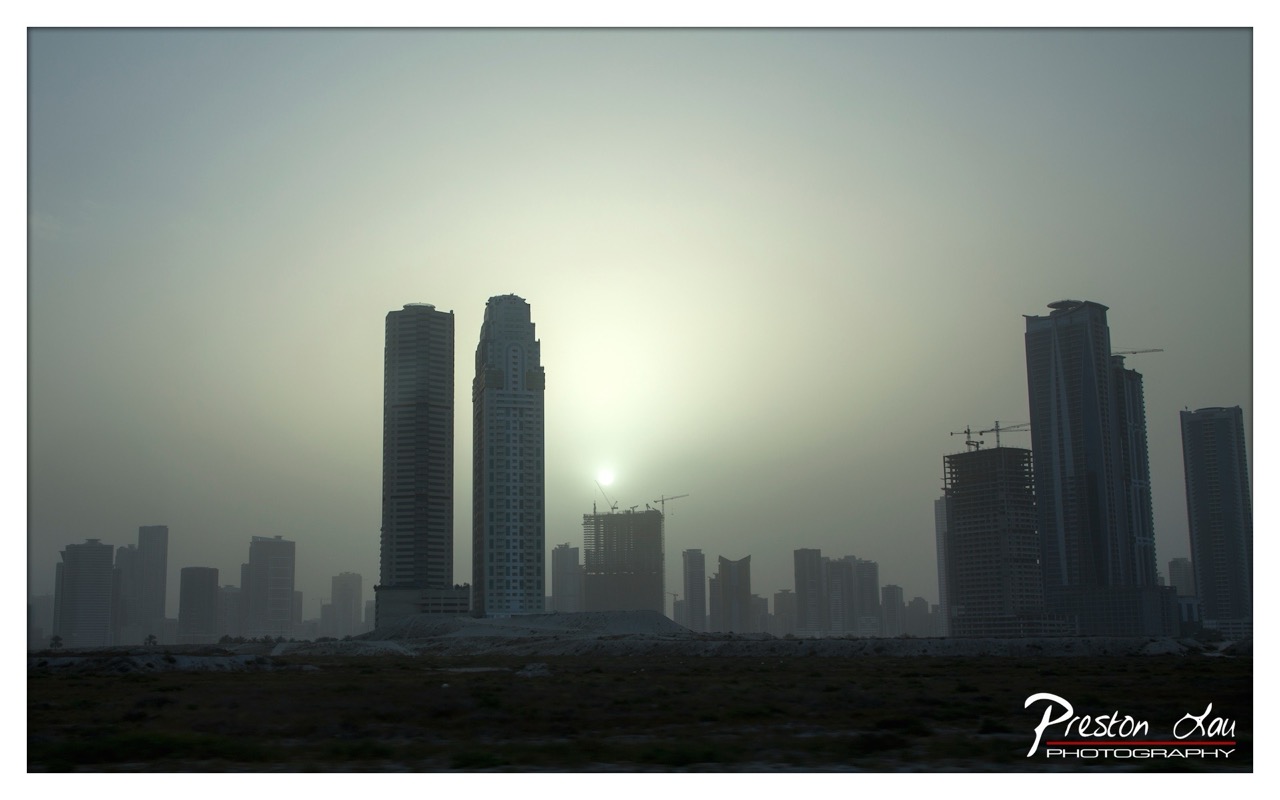

Title: City of Haze: A Skyline Lost and Found
Subject Rating: 7/10
Ah, yes, the ol' "is it sunrise or just really bad air quality?" shot. Here we have a sprawling cityscape, potentially somewhere hot and dusty, where the concrete jungle attempts to pierce a veil of atmospheric particulates. The subjects, an array of modern skyscrapers, stand tall but are softened by the thick haze. Front and center are a couple of architectural giants, looking like they're having a quiet standoff, while the rest of the city fades into a monochromatic dreamscape behind them. What's happening? Well, the sun is valiantly trying to peek through the smog, casting a gentle, almost ethereal glow. The mood is decidedly atmospheric, leaning towards moody or even a touch apocalyptic, depending on whether you see the haze as artistic diffusion or a warning sign. Despite the slightly obscured view, the sheer scale of the buildings gives the subject a solid 7/10 for sheer ambitious presence.
From a technical standpoint, the composition utilizes a low horizon line, giving maximum real estate to that glorious, hazy sky and the verticality of the buildings. The two prominent towers are placed somewhat off-center, adding a touch of asymmetry, though perhaps centering the sun within the brightest part of the haze was the goal. Lighting is where this shot truly lives or dies – the diffuse nature courtesy of the haze acts as a giant softbox, killing contrast but creating a specific mood. The muted color palette, dominated by greens, blues, and grays, reinforces this atmospheric effect, making the city look less like a vibrant hub and more like a futuristic ruin rising from the desert. The visible construction cranes add a touch of realism, reminding us this haze is the backdrop to relentless growth. The signature is tastefully placed, asserting authorship over this muted, misty vision of urban expansion.
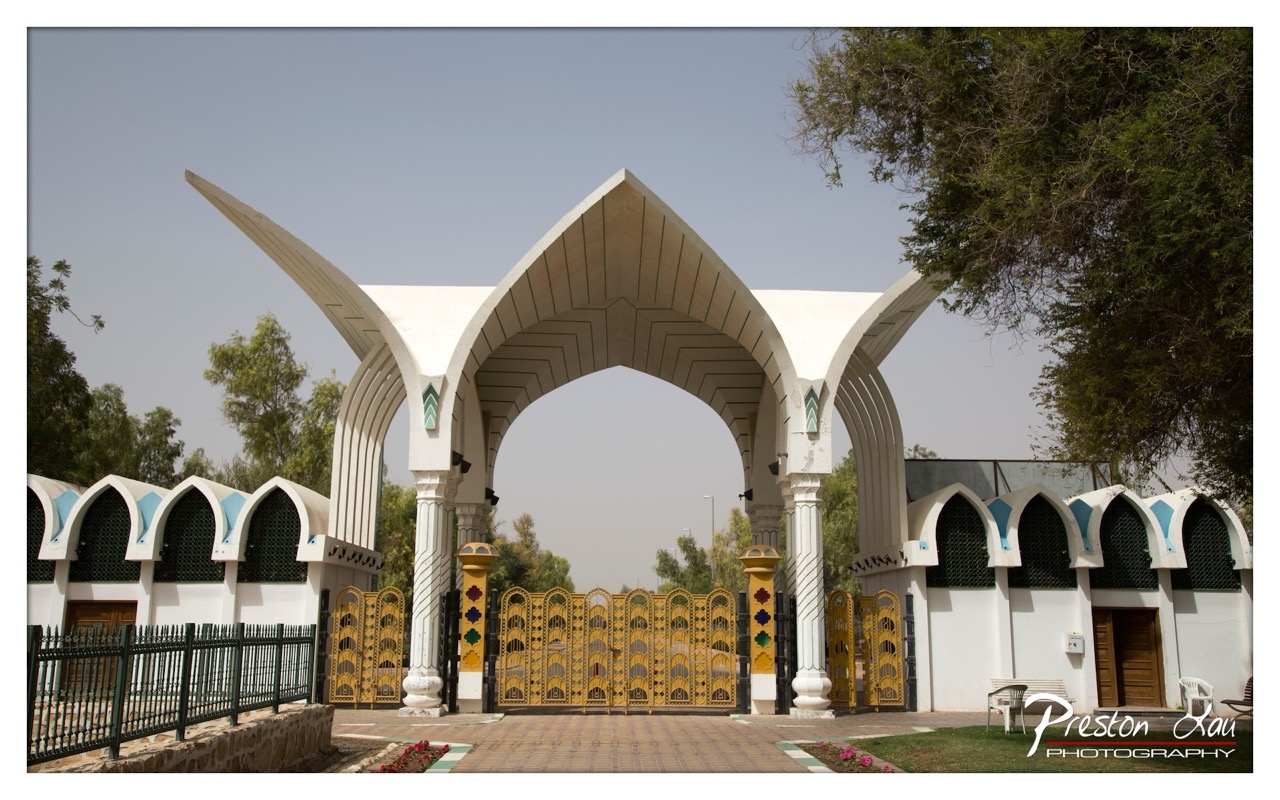

Gateway Grandeur
Rating: 7.5/10
This image presents a symmetrical, head-on view of a large, architecturally significant gateway structure standing under a bright, hazy sky. The main subject is a striking white arched entrance with intricate ribbed detailing on the underside of the arches, supported by decorative columns with minaret-like caps. This central arch is flanked by lower white buildings featuring repeated arched windows with dark screens and blue accents. At the heart of the gateway are imposing golden gates adorned with elaborate geometric patterns and circular designs, suggesting a place of importance or grandeur lies beyond. The mood is formal and somewhat quiet, dominated by the strong lines of the architecture and the intense light of what appears to be midday. Visible objects include the detailed gates and columns, a black fence, landscaped garden beds with a few flowers, a simple white bench, and notably, some white plastic chairs near the bench – a curious touch of the mundane contrasting with the formality. The background consists of scattered trees and the pale, clear sky.
From a photographic perspective, the composition is very effective due to its strong symmetry, which emphasizes the grand scale and formal nature of the gateway. However, the lighting, typical of harsh midday sun, creates significant contrast issues; the white structure features blown-out highlights and deep shadows, flattening some of the detail, while the sky is rather featureless due to the haze and brightness. The colors are dominated by the white, gold, and green, which work well together, although the harsh light diminishes some of their richness. The style is straightforward architectural or documentary photography. While the subject itself is visually compelling, the inclusion of the plastic chairs inadvertently adds a touch of levity or relatable reality to the scene – perhaps someone needed a quick rest while admiring the gate? It's a competent capture of an interesting structure, although shooting during the golden hour might have provided softer light and more textural detail, potentially elevating the overall impact. And, of course, the prominent watermark ensures the viewer knows exactly who captured this moment of architectural solemnity (and casual seating arrangements).
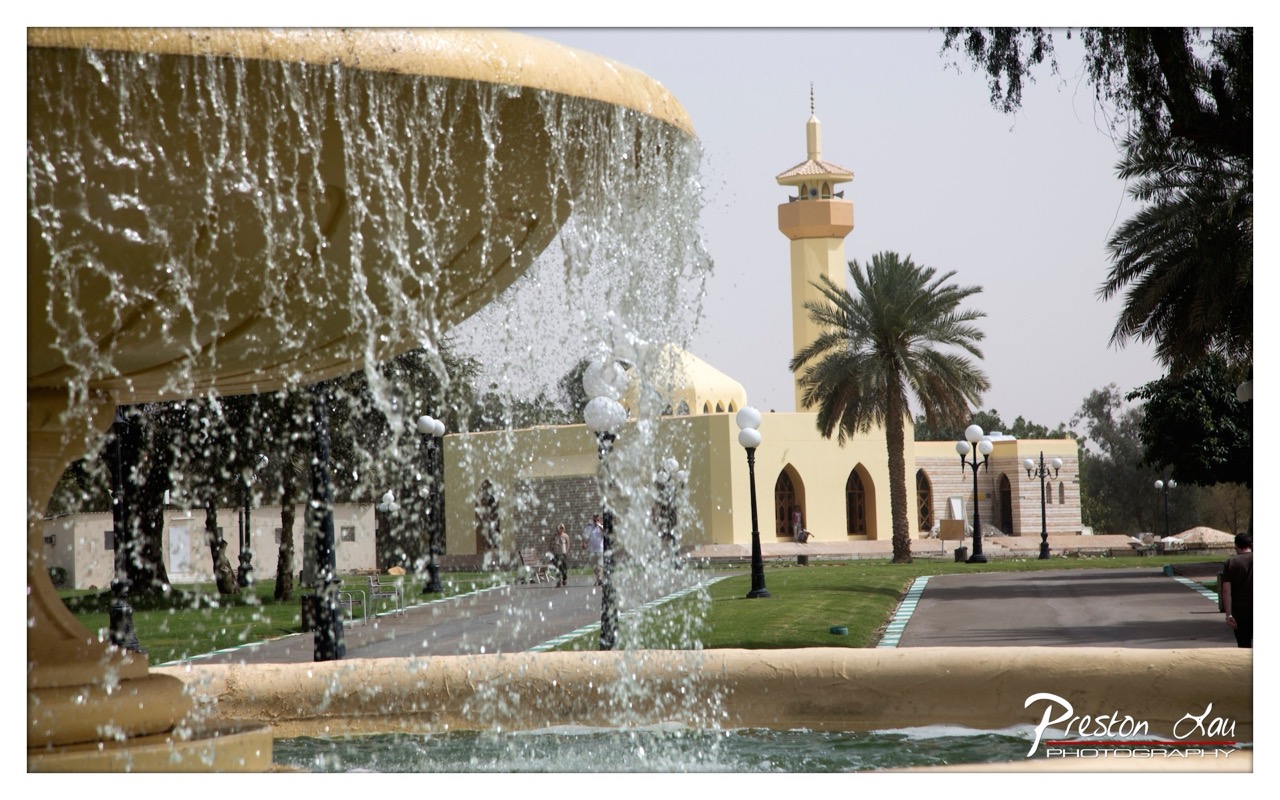

Fountain Funnel or Mosque Mirage?
Subject Rating: 7/10
This image captures a tranquil scene centered around a lively fountain in the foreground, which acts as a refreshing, albeit slightly obscuring, veil. The splashing water creates a dynamic, glittering effect, contrasting with the more static architectural elements in the background. Beyond the watery curtain, a paved pathway leads into a well-maintained park area, dotted with lamp posts and palm trees, adding a touch of desert oasis charm. Further back stands a mosque with its distinctive minaret, a focal point that anchors the scene in its geographic context. A few figures can be seen walking along the path, lending scale and a sense of gentle activity to the otherwise serene setting. The overall mood is peaceful and calm, suggesting a pleasant day spent enjoying the surroundings.
From a photographic perspective, the composition is bold, placing the gushing fountain prominently in the foreground, creating a strong visual interest. The lighting is bright, typical of midday, which makes the water pop but can also lead to slightly flat illumination on the background elements. The color palette is warm and inviting, dominated by the beige of the fountain and mosque, the vibrant green of the grass and trees, and the clear water. While the fountain provides a unique framing device, it does partially hide the main subject, the mosque, making the viewer work a bit to fully appreciate the architecture. It's a creative choice that adds visual complexity, though one might wonder if a slightly different angle could have showcased both the fountain's spray and the mosque more clearly. Capturing the intricate patterns of the water mid-splash is a nice technical detail.
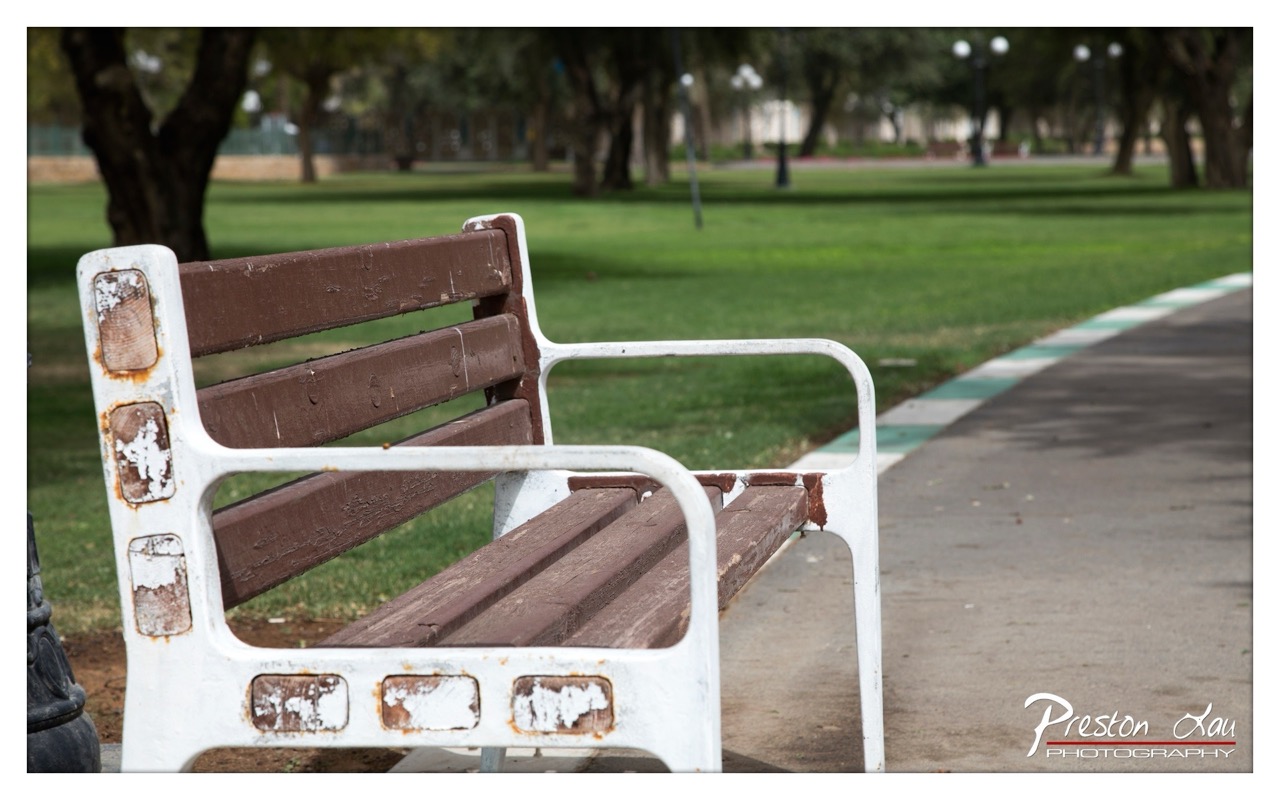

The Patient Bench
Subject Rating: 6/10
Here we have a poignant portrait of a park bench, currently unoccupied but seemingly full of unspoken stories. This isn't just any bench; it's clearly seen better days, with its once pristine white frame now peeling and showing patches of rust, and the brown wooden slats weathered and cracked. It sits patiently beside a paved path with a distinctive green and white striped edge, set within a peaceful park environment. Nothing is actively "happening" in the traditional sense, but the image captures a moment of quiet stillness, perhaps anticipating a visitor or simply resting after a long day of holding secrets and weary bottoms. The mood is contemplative, a little melancholic given the signs of age, yet serene and inviting, suggesting a perfect spot for solitude or reflection amidst the greenery.
From a photographic perspective, the composition is strong, placing the worn bench prominently in the foreground with a low-angle perspective that gives it presence. The diagonal line of the path adds depth and leads the eye into the frame, while the soft bokeh beautifully blurs the background trees and distant streetlights, isolating the bench and emphasizing its solitary state. The lighting is even daylight, which effectively renders the texture of the flaking paint and weathered wood, though a more dramatic side light might have added even more punch to the details. The color palette is dominated by earthy tones and muted greens, fitting for a park setting, with the white of the bench frame providing a key contrast. It's a skilled capture of an ordinary object, elevated by thoughtful composition and an appreciation for character found in imperfection and the simple act of waiting.
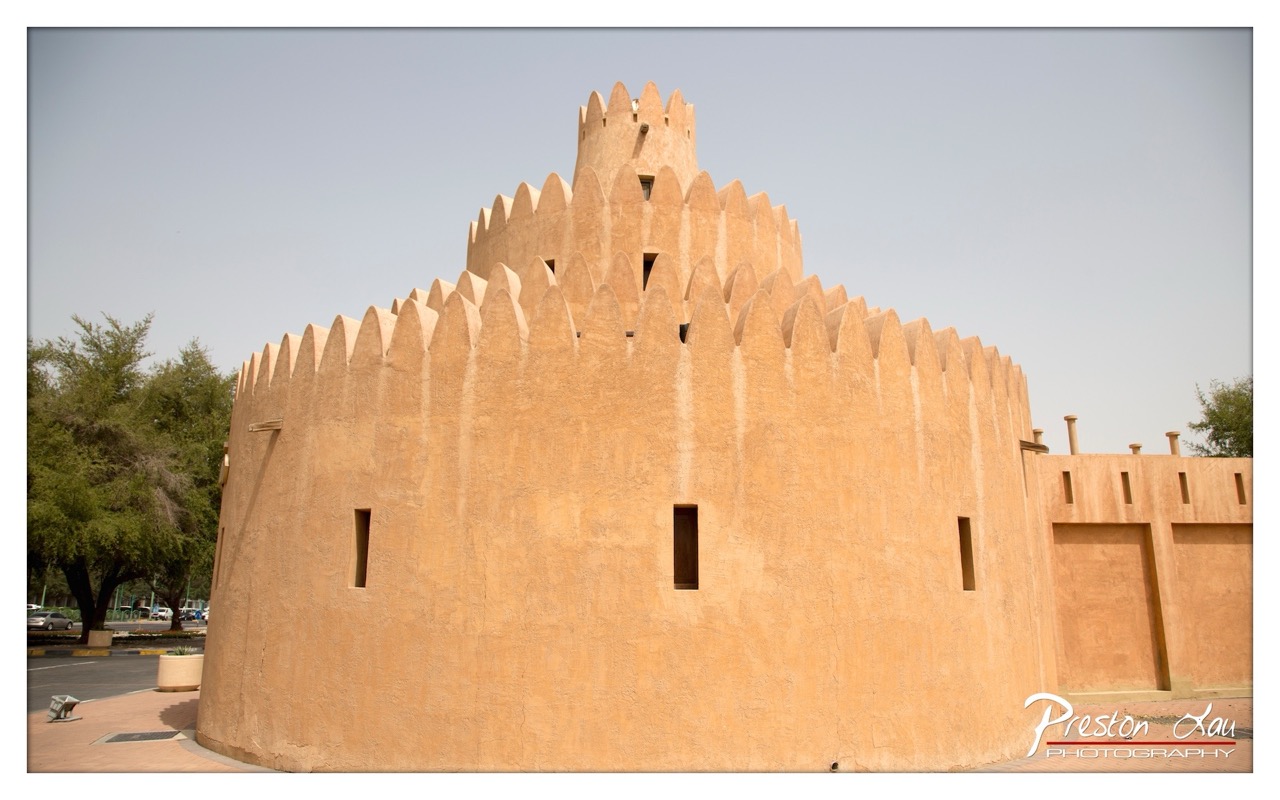

Title: The Pointy Fortress of the Pale Sky
Rating: Subject: 8/10
This striking photograph features a unique, sandy-colored circular fort or watchtower, its most distinctive characteristic being the incredibly sharp, fin-like battlements that crown its walls and central turret. It looks less like a place of defense and more like something designed by a particularly enthusiastic porcupine. The building stands stoically under a pale, slightly washed-out sky, suggesting either an overcast day or perhaps the harsh midday sun characteristic of an arid climate. On the left, the scene includes lush green trees lining what appears to be a street or parking area, with cars and pavement visible in the background, grounding the ancient-looking structure in a more modern, urban context. The overall mood is one of historical resilience meeting contemporary life, with the fort standing as a proud, if somewhat whimsically spiky, sentinel.
From a photographic standpoint, the low angle is effective in emphasizing the height and imposing nature of the building, making it feel monumental despite its modest size. The composition centers the main tower but allows the curved wall and a connecting structure on the right to lead the eye around the frame. While the natural color palette of warm earth tones and green foliage is pleasing, the bright, diffuse lighting from the sky creates relatively flat illumination, lacking the dramatic shadows or vibrant hues that golden hour light might provide, which could have added more depth and character to the textured walls. The inclusion of the road and cars on the left, while providing context, does slightly detract from the timeless quality of the fort itself. Still, it’s a solid capture showcasing an architecturally interesting subject with a clear and uncluttered view.
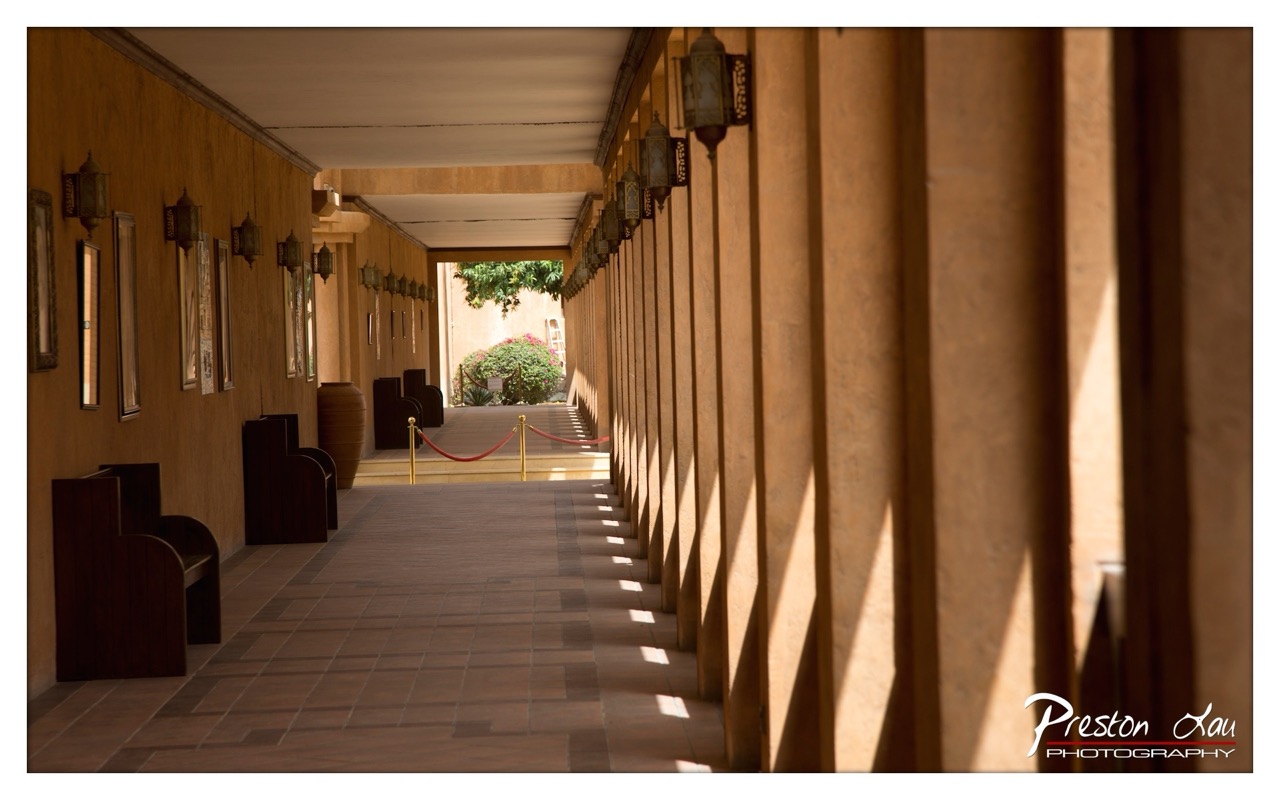

The Long Walk of Shadows
Subject Interest: 7/10
Step into this sun-drenched architectural passage, a seemingly endless corridor beckoning you forward... or perhaps suggesting you sit a spell on one of the strategically placed, dark wooden benches lining the left wall. The scene is a masterclass in repetition and rhythm, with framed art spaced out above the benches and decorative lanterns hanging uniformly from the ceiling on both sides, leading the eye down the tunnel-like space. At the far end, a glimpse of lush greenery and sunlight offers a welcome visual escape, hinting at the world beyond this structured path. There's a large, earthy pot standing sentinel on the left, adding a touch of rustic charm, while formal red velvet ropes and gold stanchions suggest this is a path you're meant to admire, not necessarily traverse freely – perhaps a waiting area for the truly patient or just a display of meticulous order.
From a photographic perspective, this shot is all about playing with light and form. The composition expertly uses leading lines created by the walkway itself and, more dramatically, by the sharp, geometric shadows cast by the pillars on the right. These repetitive shadows create a powerful pattern that dominates the right side of the frame, contrasting sharply with the more static left side. The harsh, directional sunlight is the real star here, transforming simple architectural elements into abstract shapes and lines on the floor – a photographer's playground for light and shadow studies. The warm, earthy tones of the walls and floor tiles create a cohesive and inviting palette, grounding the scene in a feeling of warmth. It's a great example of how capturing the interaction between light and structure can turn a simple corridor into a compelling image.
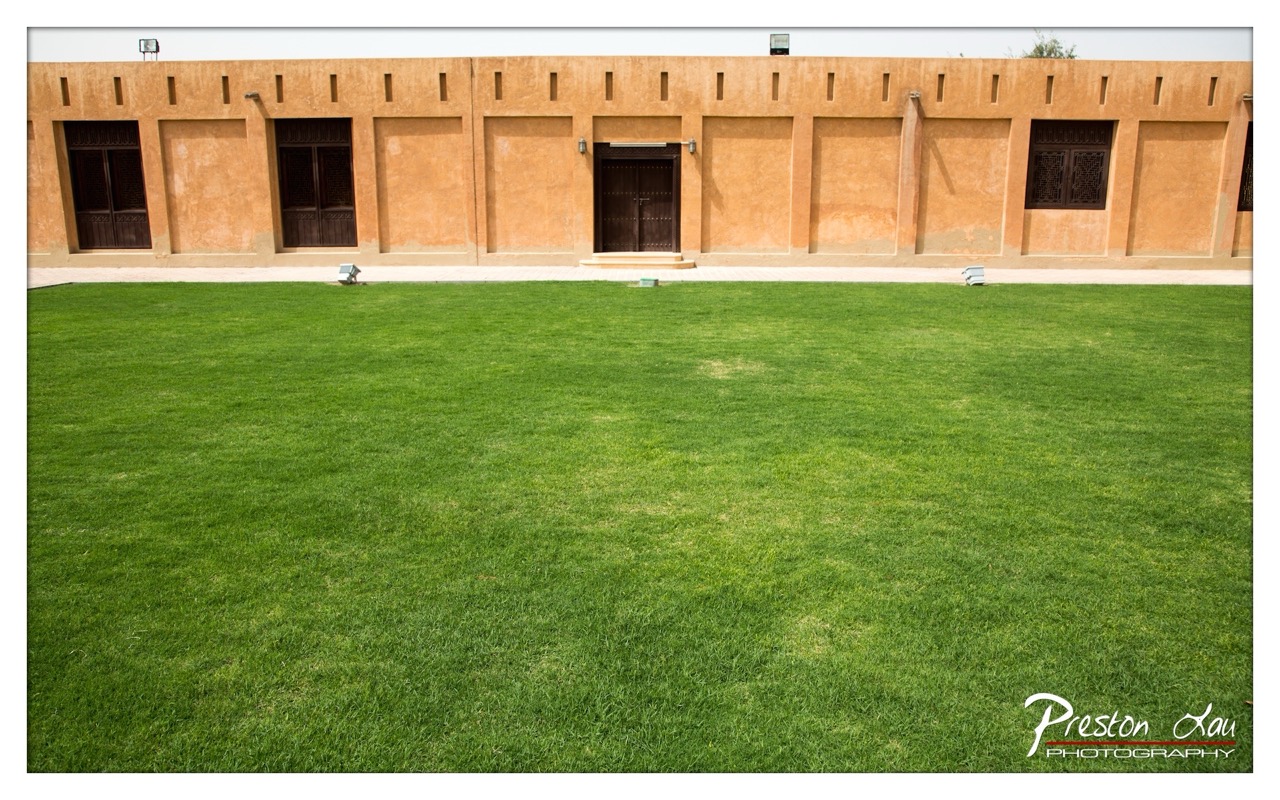

The Serene Wall and the Verdant Lawn
Subject Rating: 6/10
Here we have a scene that practically whispers 'stillness'. The main subject, a long, sand-colored building with a robust, almost fortress-like appearance, stands like a silent sentinel behind a vast expanse of perfectly manicured green lawn. Symmetrical windows and a central, imposing doorway give the structure a sense of balance and purpose, even if that purpose seems to be "just stand there and look architecturally significant." The mood is undeniably peaceful, perhaps even a little stoic, captured in a moment where absolutely nothing appears to be happening, allowing the viewer to simply appreciate the lines and colors presented.
From a technical perspective, the composition is strong, employing a classic rule of thirds layout with the building occupying the central horizontal band and the expansive lawn dominating the foreground. The perspective, slightly elevated above ground level but still low, emphasizes the depth of the lawn before the wall. The lighting is notably flat, suggesting bright but diffused light, which eliminates harsh shadows but also removes much of the potential for dramatic form and texture to be highlighted on the building. While the colors – the warm orange-brown of the building, the intense green of the grass, and the bright white sky – are distinct and pleasingly contrasting, the overall effect is perhaps a little too clean, bordering on clinical. It's a competent, clear shot of the architecture and landscape, perfect for a catalogue, but one might yearn for a touch more character or dynamism introduced by more varied lighting or a hint of life. Also, the dedication required to keep that grass looking like a putting green deserves a separate rating entirely.
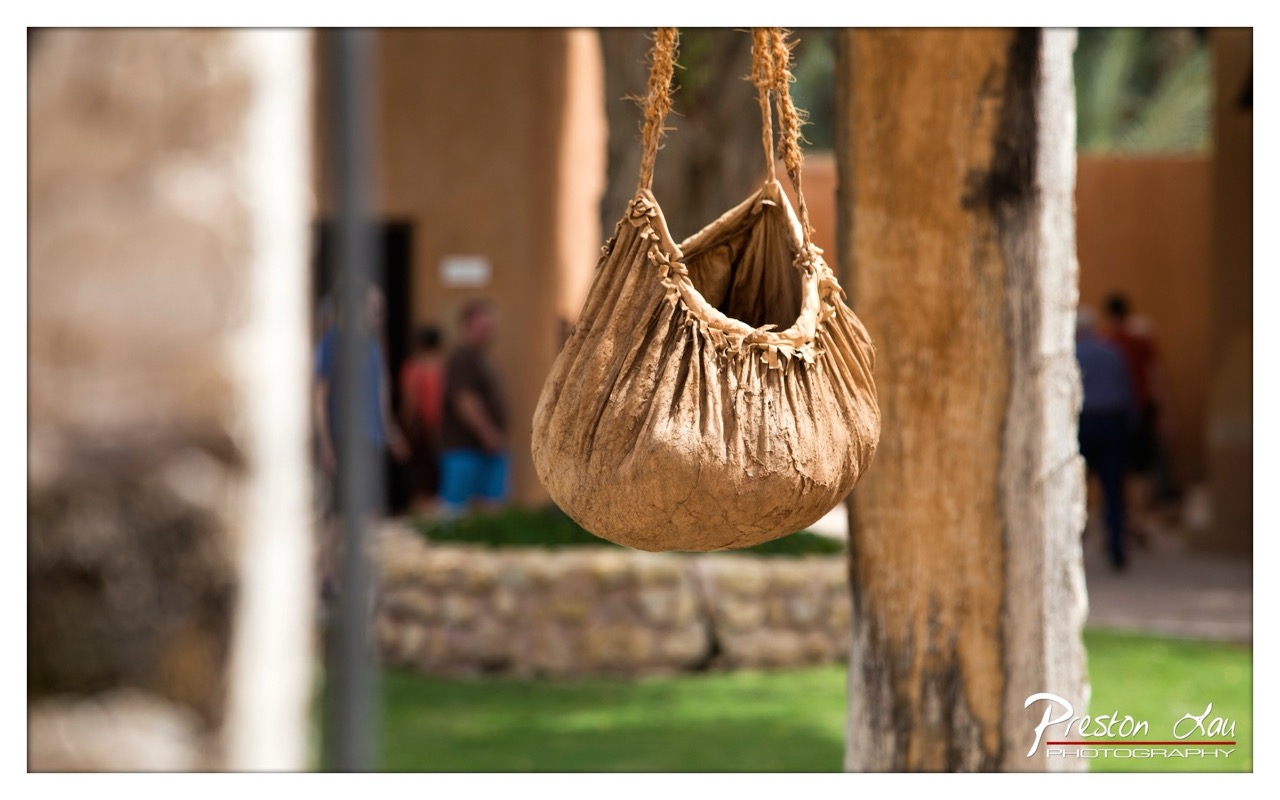

The Mystical Hanging Pouch
Rating: 6/10
Behold, the noble hanging pouch! This image elevates a seemingly simple object to a place of reverence, capturing a textured, aged sack suspended by rope, looking as though it holds ancient secrets or perhaps just someone's lunch. It hangs prominently in the frame, demanding attention despite its humble nature. In the background, life unfolds in a relaxed, sunny environment; blurry figures mosey about near a building, while a low stone wall and green grass hint at a pleasant outdoor setting. The mood is quiet and contemplative, inviting the viewer to ponder the pouch's purpose and history, or maybe just appreciate the artistry applied to an everyday item.
From a photographic perspective, this shot is a masterclass in subject isolation using shallow depth of field. The focus is critically sharp on the fabric textures and woven rope of the pouch, while the background dissolves into a creamy bokeh, rendering the people and environment as soft, abstract shapes. The composition places the pouch slightly left of center, balanced by the strong, vertical presence of a tree trunk on the right, which provides a rustic foreground element and helps frame the scene. The natural lighting is soft and even, beautifully highlighting the intricate wrinkles and worn surface of the sack. The warm, earthy color palette ties the subject and environment together harmoniously, creating a cohesive and visually appealing image, proving that even the most unassuming subject can become captivating with the right technical approach.
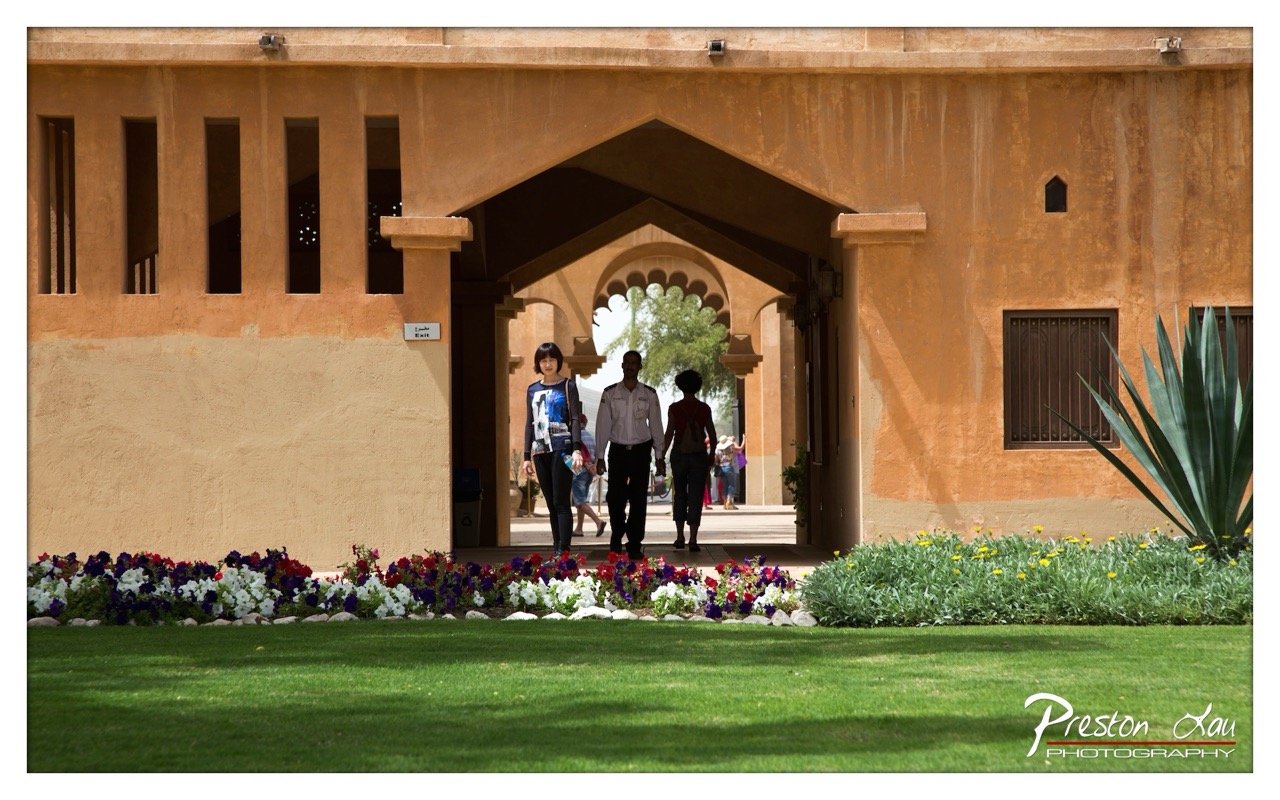

Stepping into the Light
Subject Rating: 7/10
Here we have a classic scene: three figures emerging from the shadows of a grand archway, walking towards the bright, sun-drenched world outside. The subject is essentially the human element interacting with striking architecture and a beautifully maintained garden. What's happening is pretty straightforward – they're taking a stroll out of a building, possibly finishing a visit somewhere interesting, maybe looking forward to grabbing a snack or just enjoying the fresh air after being indoors. The mood feels warm and pleasant, evoking a sense of transition or journey. The composition wisely uses the arch as a natural frame, drawing the eye directly to the people and the view beyond. The lush, green grass and vibrant flower bed in the foreground add a lovely splash of color and texture, providing a nice contrast to the warm, earthy tones of the building. It’s almost like a welcoming committee of petunias guiding you into or out of the frame.
Now, let's talk photography nuts and bolts. The lighting here is quite direct, which is evident from the strong shadows cast on the grass. This presents a classic challenge – balancing the bright exterior with the darker interior of the archway. While the people are slightly silhouetted against the brighter background, their details are still reasonably visible, which is a win. The color palette is dominated by the warm oranges and yellows of the building, beautifully complemented by the cool greens of the foliage and the pops of red, white, and purple from the flowers. The background reveals more arches and distant figures, suggesting a larger complex or public space, adding depth. The shallow depth of field, or perhaps just the distance, blurs the far background nicely, keeping the focus squarely on the main subjects and the immediate surroundings. The style is typical of travel or architectural photography with a focus on human scale and interaction. Overall, a well-composed shot that captures a moment, even if the harsh midday sun wasn't the photographer's best friend that day – but hey, sometimes you gotta shoot when you gotta shoot! And kudos to Preston Lau for signing his work – always a pro move!
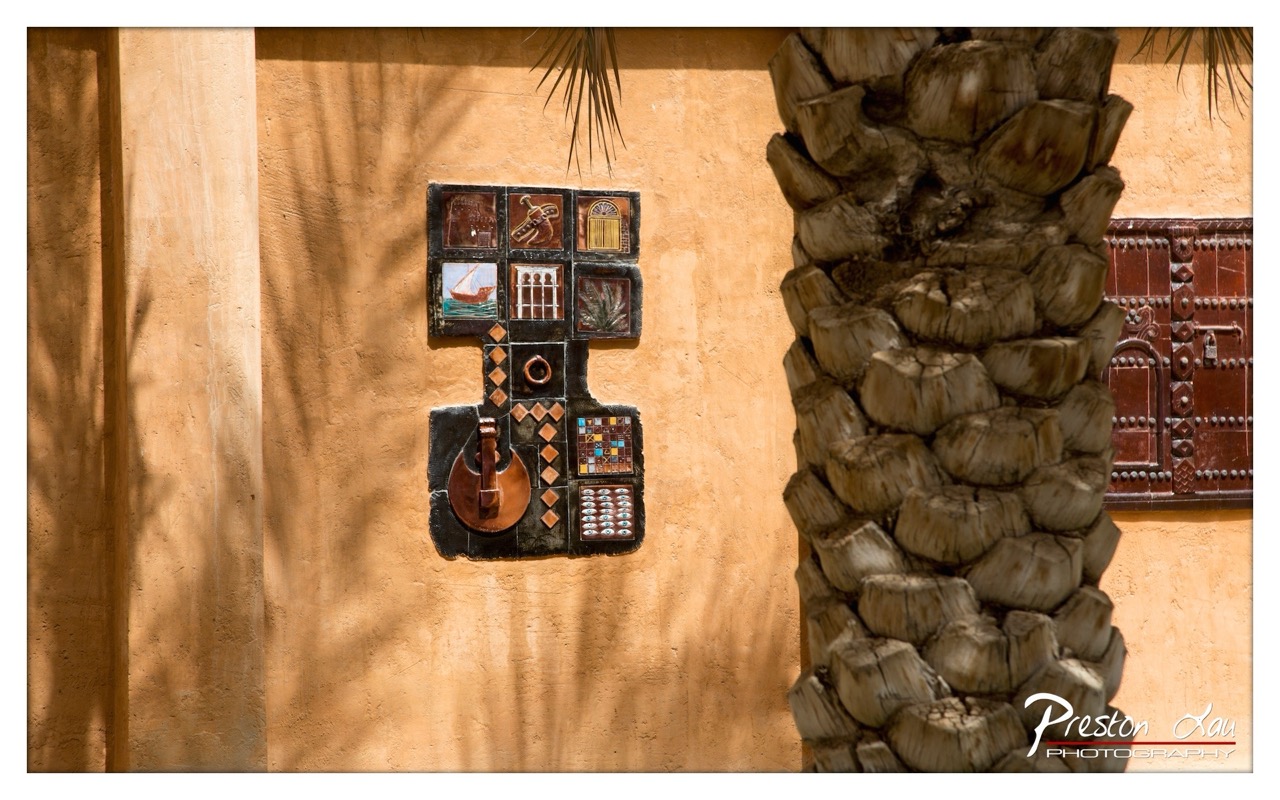

Tales from the Wall (and a Giant Trunk)
Subject Rating: 8/10
This image captures a delightful, richly textured slice of life or history displayed on a warm orange wall. The primary subject is a unique mosaic art installation, a charming cluster of tiles featuring various scenes and patterns – a tiny boat sailing, an arched window, plant motifs, geometric shapes, and a central, almost guitar-like form. The artwork tells a visual story, adding a touch of cultural depth to the scene. To the right, a substantial, roughly textured palm tree trunk stands proudly, partially obscuring the wall and a glimpse of a studded wooden door in the background. Strong sunlight casts dramatic, dappled shadows across the wall, hinting at the time of day and adding a dynamic, organic element to the static scene. The overall mood is warm, inviting, and slightly enigmatic, drawing the viewer into this quiet corner.
From a photographic perspective, the composition is an interesting, if slightly unbalanced, interplay between the static art and the dominant natural element. The palm tree serves as a heavy right-side anchor, creating a strong vertical line that competes with the off-center mosaic. While it provides context and a sense of place, its sheer mass could be seen as a potential distraction from the main subject. The lighting is a highlight, with the harsh sunlight beautifully illuminating the texture of the wall and the intricate details of the mosaic tiles, while the leaf shadows add visual interest and depth. The warm color palette, dominated by oranges, browns, and the earthy tones of the mosaic, creates a cohesive and inviting feel, though the contrast between the bright wall and the dark shadows is quite high. It's a great example of capturing local detail, even if the palm tree is clearly vying for 'best supporting actor' in this wall drama.
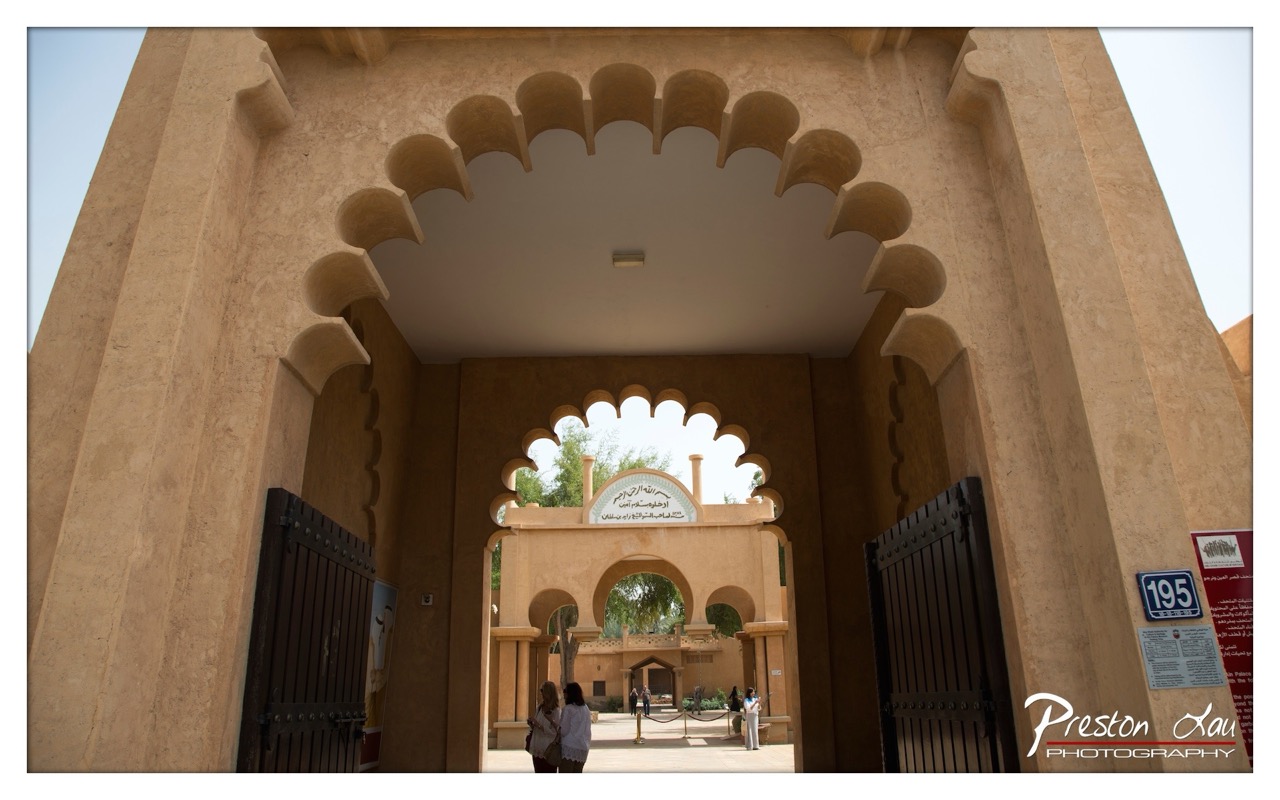

The Grand Entrance: A Study in Arches
Rating: 7.5/10 (for the architectural subject)
Talk about making an entrance! This photo captures a seriously impressive archway, showcasing that classic Islamic or Moorish architectural style with its numerous scalloped arches stacked like delicious little biscuits. The subject itself is a solid 7.5 – visually rich and intriguing, promising something grand beyond. What's happening is pretty straightforward: people are navigating this magnificent doorway, probably trying to figure out which arch leads to the quickest exit or the most shade, under what appears to be a rather bright sky. The mood is one of historical weight and a touch of awe at the structure's scale, mixed with the casual bustle of visitors. It feels like the entry to a hidden gem or a historical site, bathed in the warm, earthy tones that are typical of the region.
From a photographic perspective, the composition uses a low angle to emphasize the sheer height and grandeur of the main arch, creating a dramatic perspective. The framing effect of the outer arch around the inner courtyard scene adds a nice sense of depth, inviting the viewer inside. However, the bright daylight creates some challenging lighting conditions, resulting in deep shadows under the arches and a slightly blown-out sky – a classic battle against harsh sun. The color palette is dominated by warm tans and browns, which are true to the subject but could perhaps benefit from softer light to bring out more detail. The inclusion of the people provides scale and context, showing just how imposing the structure is. The signs on the right wall, including the address "195," add a touch of real-world context to the otherwise timeless architecture, while the prominent watermark reminds us whose sunny struggle this is. Overall, a strong subject presented with a dynamic composition, though the lighting presents typical midday challenges.
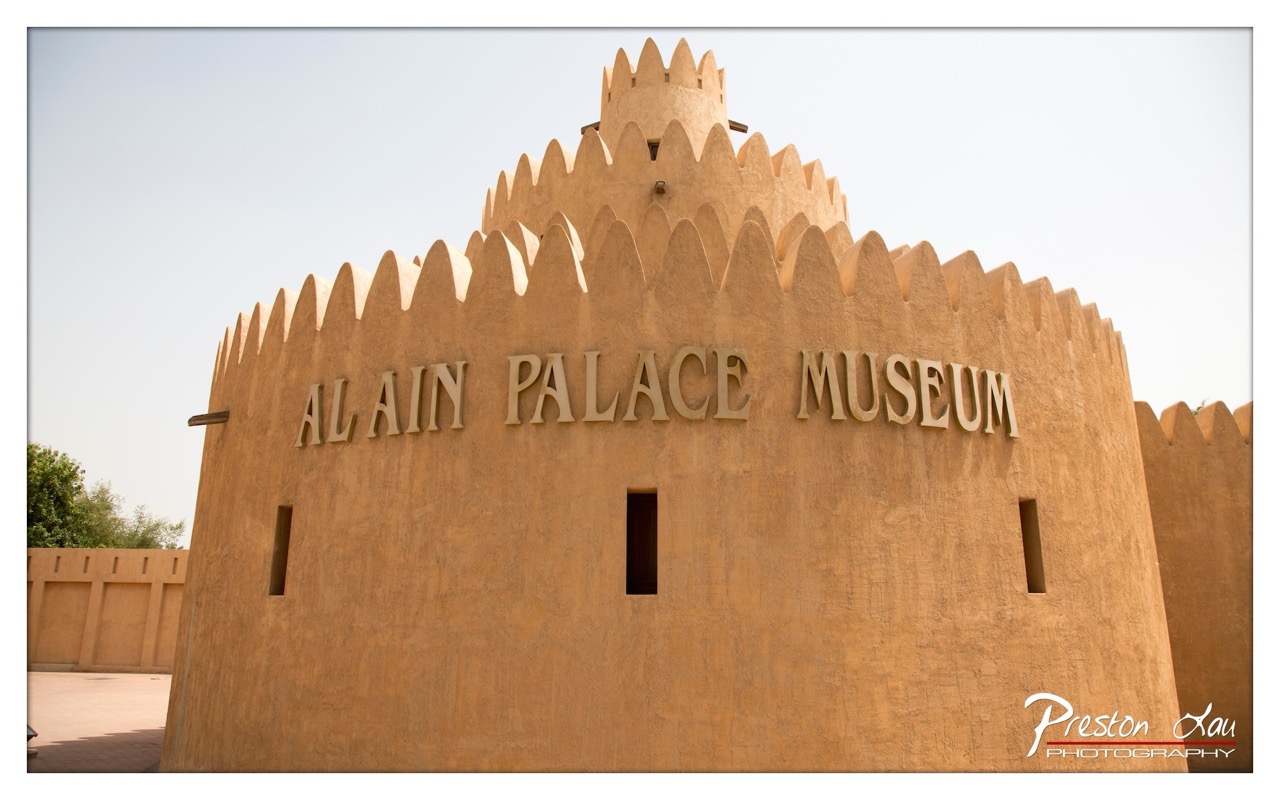

Title: Sandy Fortress of Al Ain
Rating: 7/10
Behold the Al Ain Palace Museum, standing tall and proud like a giant sandcastle that somehow survived the tide – and centuries! This impressive structure, captured from a low angle, truly emphasizes its scale and rather formidable, battlement-topped silhouette. It’s a peaceful, historical mood, almost like the building is quietly contemplating all the history it's witnessed. While nothing is actively happening – it’s a museum, not a rave – the static subject matter is rich in texture and architectural detail, providing a solid foundation for a classic travel shot. The sign spelling out "ALAIN PALACE MUSEUM" is a rather helpful addition, ensuring no one mistakes this historical landmark for an oversized loaf of artisanal bread.
From a photographic standpoint, the low-angle composition gives the building a sense of grandeur, making the jagged battlements seem like dragon's teeth against the sky. The lighting appears to be direct, probably midday sun, which results in strong illumination on the facade and some noticeable shadows under the letters. While bright sun can be tricky, it does highlight the warm, earthy tones of the building material beautifully, fitting the desert context perfectly. The background is simply a clear sky and a bit of surrounding wall and greenery on the left, keeping the focus squarely on the main structure. It’s a straightforward architectural shot, perhaps a bit stark in the bright light, but effective in showcasing the unique character of this historical museum. And yes, there's the watermark, letting us know who captured this sunny slice of history.
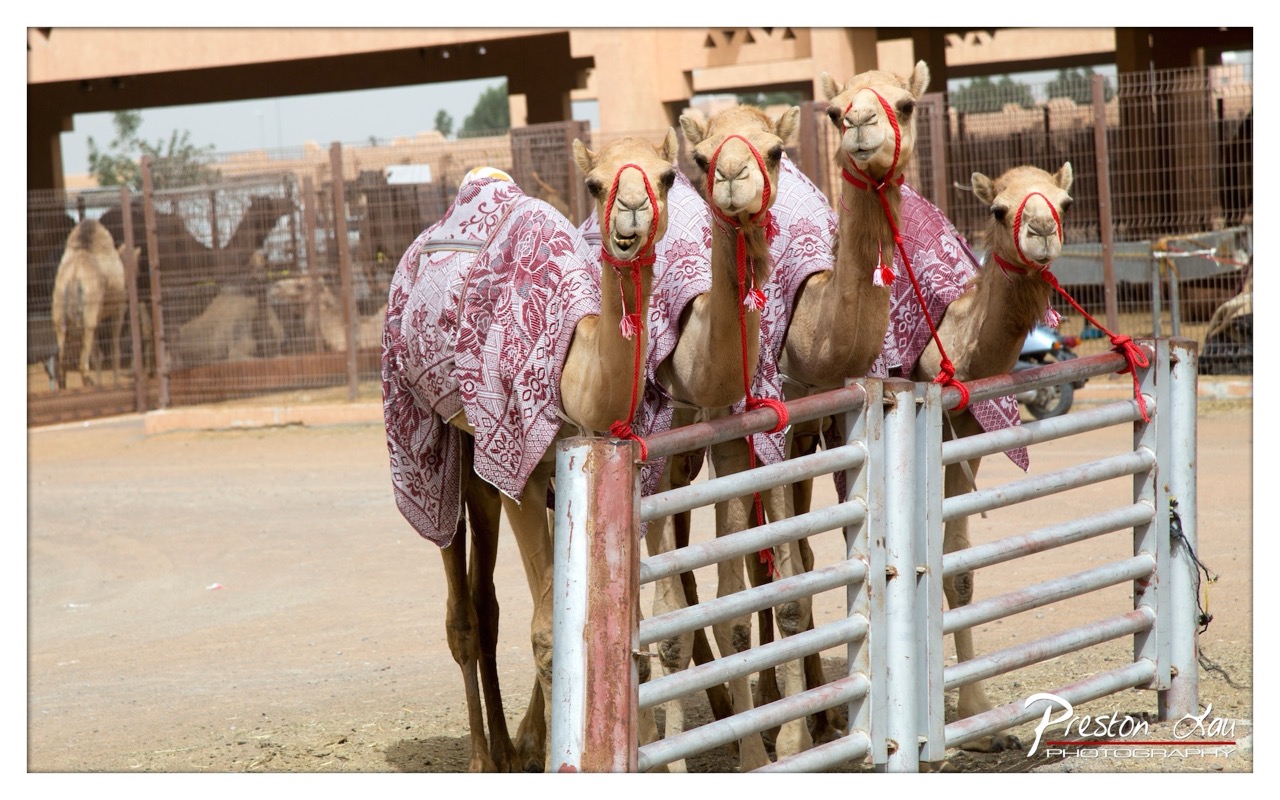

The Fab Four Hump Day
Subject Rating: 8/10 (Four camels in matching outfits? Instant classic. They look ready for their album cover shoot.)
This image presents a delightful scene of four dromedary camels peering over a metal fence, each sporting a snazzy maroon and white patterned blanket and tied with festive red ropes around their heads and muzzles. They're lined up almost like a boy band posing for the paparazzi, with expressions ranging from placid contemplation to what looks suspiciously like a camel smile. The overall mood is one of curious engagement; you feel like you've stumbled upon a VIP section at the camel market. The subject matter is unique and culturally interesting, capturing not just the animals but also the local custom of decorating them, perhaps for sale or a festival. It’s a moment of unexpected charm and personality from creatures often seen as stoic.
From a photographic viewpoint, the composition uses the fence as a strong horizontal line that grounds the image and provides a visual barrier, forcing the viewer's attention to the camels' heads and necks. The bright, direct lighting creates some harsh shadows, particularly under the camels' chins and around their eyes, which is a common challenge in midday sun, making you wish for a little diffusion or softer light. However, the warmth of the light complements the camels' fur and the sandy environment beautifully. The color palette is dominated by earthy tones with vibrant pops of red from the ropes and blankets, adding visual interest. The background clearly establishes the setting as a market or large enclosure, with more fences, buildings, and even a glimpse of another camel or two in the distance, adding context and depth to the scene. Despite the challenging light, the focus is sharp on the front camels, capturing their expressions and the intricate pattern of their blankets.
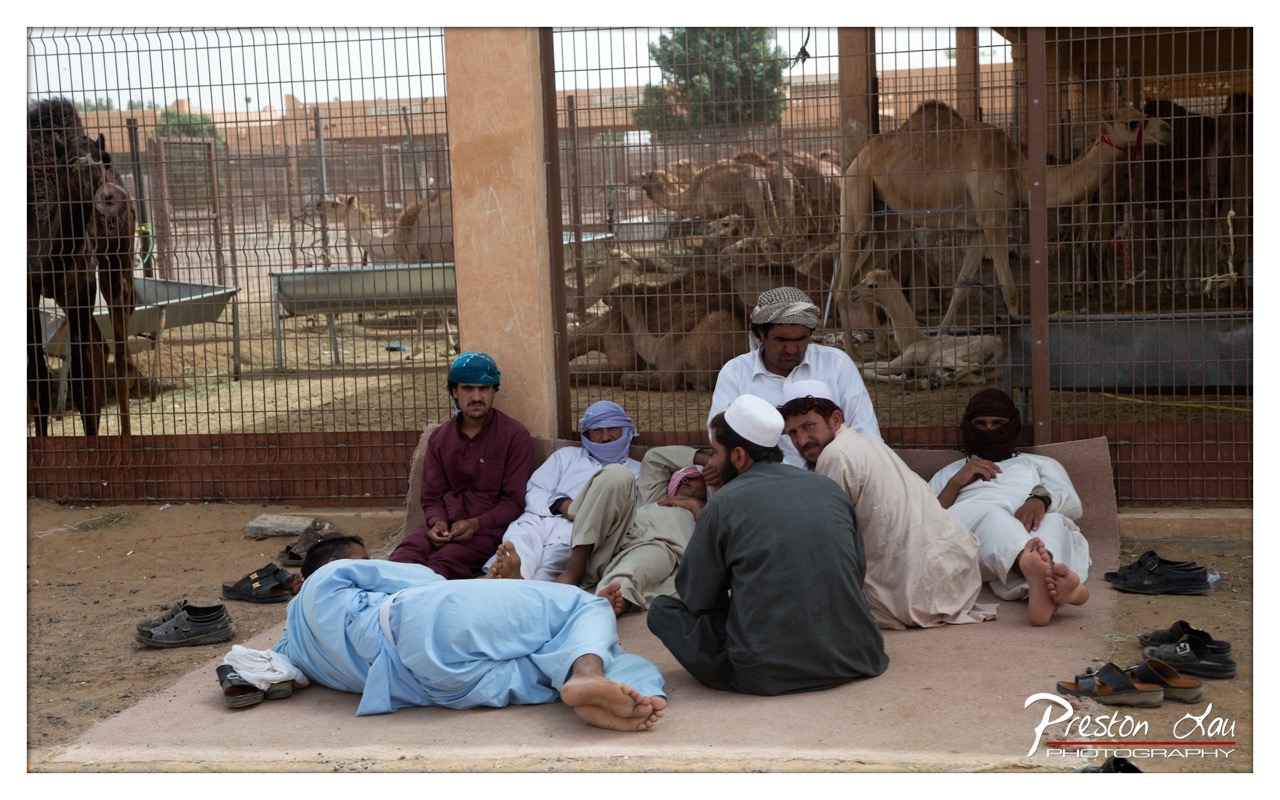

Title: The Committee on Napping and Camel Affairs
Rating: Subject Matter: 8/10
This fascinating image presents a scene of leisurely repose among a group of men, likely taking a break at a camel market or rest area. In the foreground, a collection of figures occupies the lower portion of the frame, some seated and engaged in conversation, others fully committed to horizontal relaxation – one brave soul is even face down, achieving peak relaxation efficiency. Their varied traditional attire adds texture and color, from the deep maroon and light blue to the more common white thobes and head coverings. The scattered shoes in the foreground are a relatable detail, signifying a moment where formality is happily abandoned for comfort. The overall mood is one of calm and perhaps weariness, a quiet interlude in what might otherwise be a bustling environment.
Behind this human tableau lies the reason for their presence: a fenced enclosure filled with camels. The camels, in various states of standing and resting, are the backdrop to the human activity, adding a distinct sense of place and purpose to the scene. From a photographic standpoint, the composition is layered effectively, using the prominent wire fence as a divider between the human foreground and the animal background, creating visual depth. The natural lighting is soft and diffused, providing even illumination that captures the details without harsh shadows. The color palette is dominated by warm earth tones, contrasting subtly with the blues and whites of the men's clothing. It's a candid, photojournalistic style capture that feels authentic, perfectly balancing the human element with the context of their surroundings.
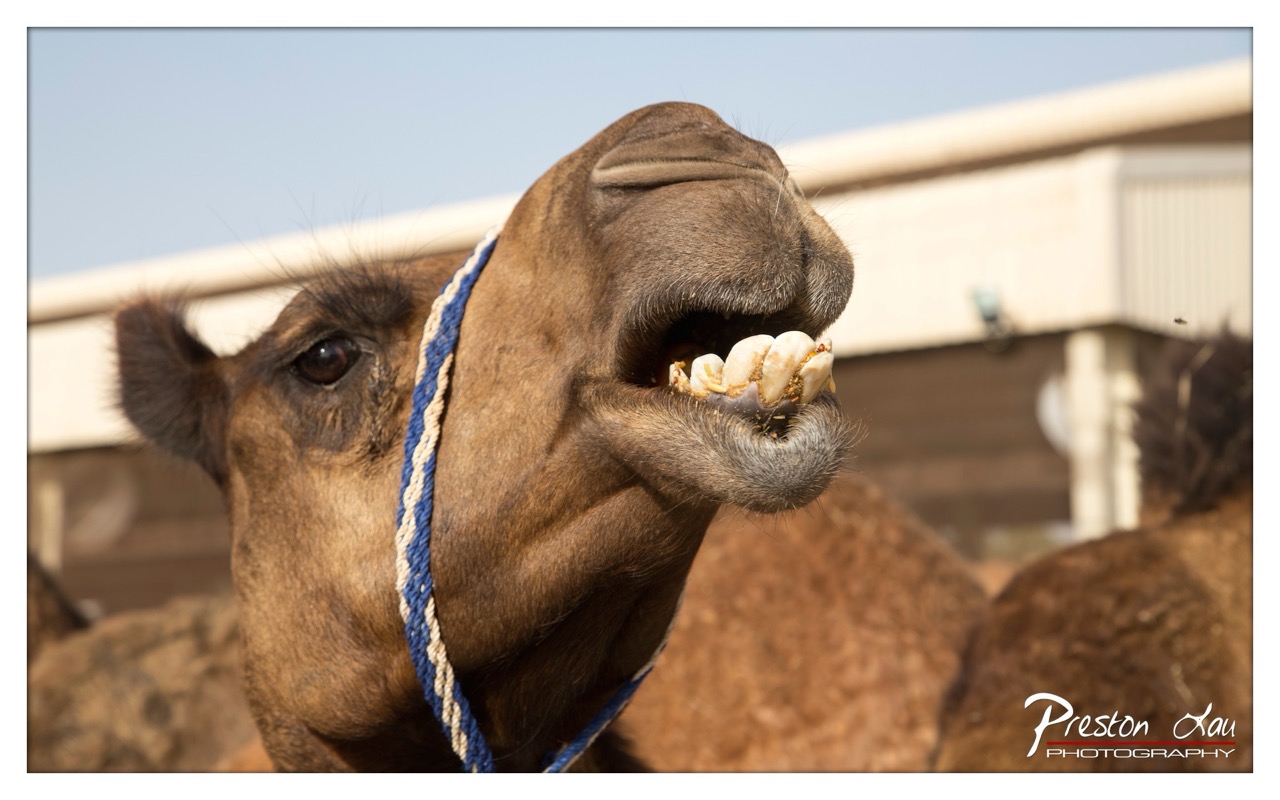

Say Ahhhh! A Camel's Dental Close-Up
Subject Rating: 8/10 (For the sheer comedic timing and dental drama)
This frame captures a wonderfully candid moment of a camel giving the photographer what can only be described as a slightly unsettling, yet hilarious, grin. With a blue and white rope halter adding a splash of colour, the camel is seen here with its mouth wide open, proudly displaying a set of robust, if slightly stained, teeth. The tight, angled composition brings us face-to-face with this dromedary diva, focusing intently on its expressive face and that unforgettable dental display. The mood is undeniably humorous and quirky, making you wonder what exactly prompted this open-mouthed moment – perhaps it was mid-chew, mid-bray, or simply posing for its dental records.
From a photographic perspective, the shallow depth of field effectively isolates the camel's head from the background, ensuring all attention is on our star subject and its gleaming (or not so gleaming) teeth. The natural light beautifully highlights the texture of the camel's fur and the rough surface of its chompers. The blurred background provides context, hinting at an enclosure or stable with a beige building, while another soft camel form lurks in the distance, almost photobombed by a tiny, perfectly focused fly. This shot expertly uses timing and a low angle to create an engaging and comical animal portrait that's less about majestic desert creatures and more about charismatic, toothy individuals, perfectly capturing a moment of unique camel personality.
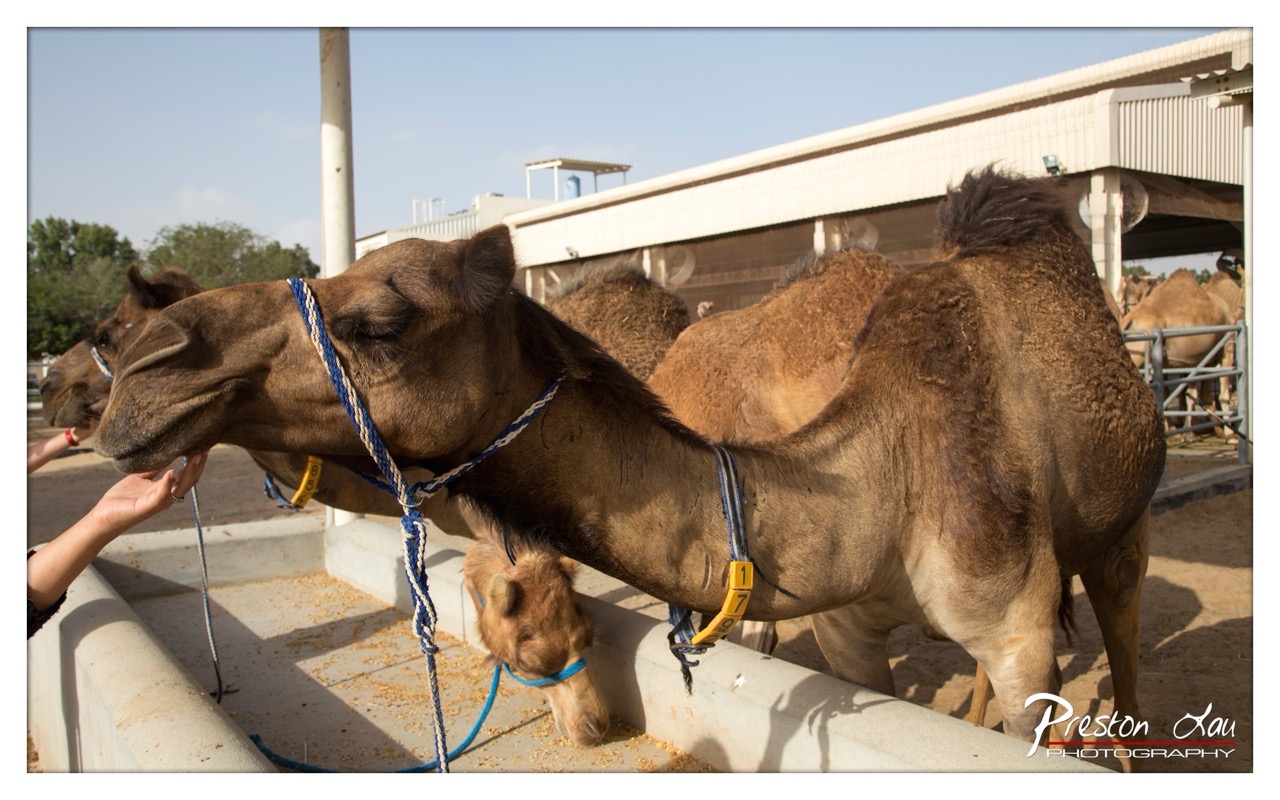

Camel Charisma and Questionable Sun Angles
Subject Rating: 8/10 (Camels are inherently cool, even if they look a bit grumpy)
Welcome to the camel meet-and-greet, where one brave soul is getting up close and personal with some seriously fluffy neck action. Our main star, a handsome dromedary sporting some fashionable blue and white rope accessories and a rather fetching numbered tag (looking at you, #17), is accepting pets – or perhaps expecting snacks – from a disembodied hand entering from stage left. There's a whole crew hanging out by the concrete trough, which is conveniently scattered with some golden treats. Peeking out from under the main camel's impressive neck is a little baby camel, presumably waiting for its turn for head scratches or just trying to stay out of the harsh sun. The mood is surprisingly serene despite the potential for spitting (just kidding... mostly), highlighting a moment of gentle interaction in what seems like a busy stable or farm environment.
From a photography perspective, this shot has potential but struggles with the classic desert photography foe: harsh midday light. The sun is creating some seriously strong shadows off the trough and poles, while also blowing out highlights on the camels' fur and the white building in the background. Compositionally, the main camel's head is well-placed and draws the eye, but that pole cutting into the frame on the far left is a bit distracting, as is the rather aggressive watermark that takes up valuable real estate. While the earthy tones are accurate for the environment, a softer light would have brought out the textures and colors of the camels' fur more effectively. The background gives context with other camels and stable structures, but isn't particularly dynamic. Overall, it captures a fun moment, but the technical execution is hampered by the lighting and the overzealous branding.
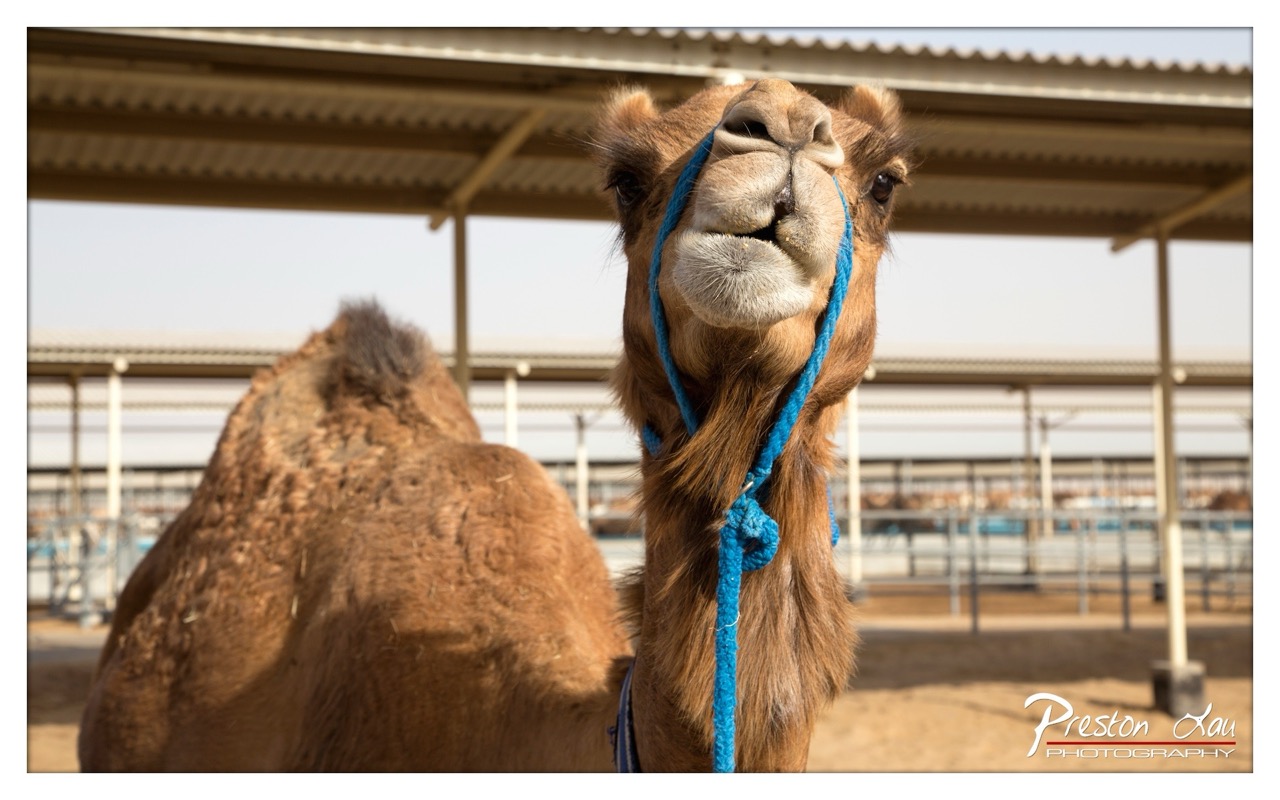

Camel Close-up Stare Down
Subject Rating: 9/10
Well hello there! This dromedary definitely isn't shy, staring down the lens with an expression that says "What do you want?" or perhaps "Got any dates?" The subject is fantastic – camels always have interesting faces and textures, making them prime candidates for portraits. What's happening here is simply a direct interaction between the photographer and the subject, capturing a moment of curiosity or perhaps mild annoyance from the camel. The mood is immediate and engaging, pulling the viewer right into the frame thanks to the tight crop. We get a great look at the camel's mouth, whiskers, and expressive eyes, framed by that surprisingly vibrant blue rope halter which adds a splash of unexpected color to the otherwise earthy palette.
From a technical standpoint, the composition is a bold close-up, focusing almost entirely on the camel's head. While it sacrifices the context of the full animal (save for a peek at the blurry hump in the back), it creates a strong connection with the subject's personality. The background, a slightly blurry but discernible structure of a holding pen or market, provides some context without being distracting due to the shallow depth of field. Lighting appears to be bright, possibly direct overhead sun, which highlights the fur texture nicely but creates some noticeable shadows, particularly under the chin. The focus is spot-on, capturing the details of the face and the blue rope. It's an effective animal portrait that uses proximity and a striking subject to create impact, proving you don't always need perfect studio light to capture a compelling character.
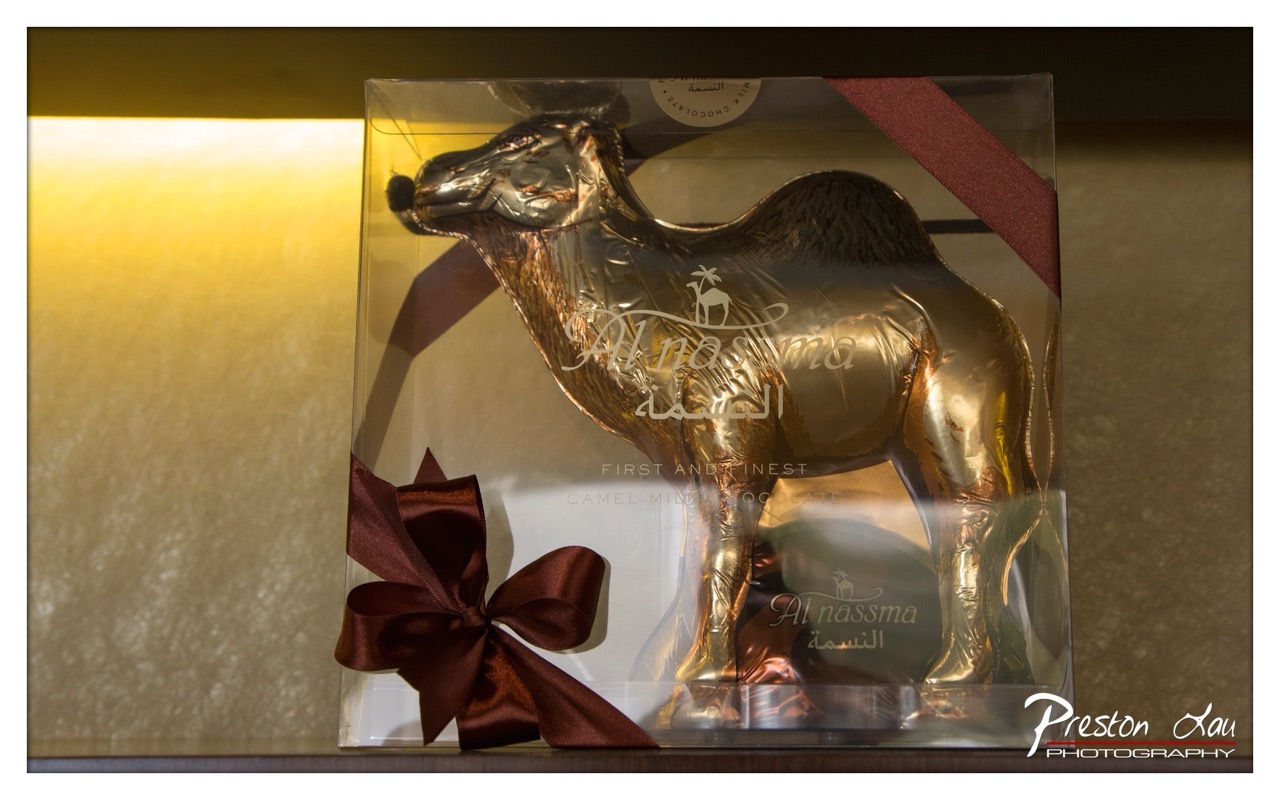

Camel-toe-tally Delicious Sculpture
Rating: 8/10 (for sheer novelty and shiny goodness)
Well, hello there, magnificent beast! We've got a contender for the most opulent chocolate creation in the desert, perhaps the world. This isn't just any chocolate camel; it's a full-sized, glistening gold foil-wrapped dromedary, proudly presented in a crystal-clear display box, complete with a dashing brown ribbon bow. It's like the Willy Wonka of the Arabian Peninsula decided a standard bunny just wasn't grand enough. The subject matter itself is inherently humorous – a giant chocolate camel! – but the presentation elevates it to a level of almost regal decadence. The box highlights the camel's majestic (and undoubtedly meltable) form, suggesting this is more than just a sweet treat; it's a statement piece, likely destined for a very special occasion, or just a moment of extreme chocolate indulgence.
From a photographer's perspective, capturing something this shiny and wrapped in crinkly foil is a delightful challenge. The lighting has done a decent job here, creating bright highlights across the gold wrapper, emphasizing the camel's sculpted contours and the texture of the foil itself. It helps the subject pop against the blurred, warm-toned background, which adds a touch of luxury appropriate for such a lavish item. Compositionally, the camel is placed centrally, its elegant profile taking center stage, while the ribbon adds a touch of visual interest in the foreground. The photographer managed to avoid excessive glare reflections on the plastic box, which is a common pitfall with this kind of subject. It’s a clean, effective product shot that makes the gold camel look almost impossibly desirable, despite the inherent silliness of a chocolate beast. Definitely a conversation starter for any dessert table.
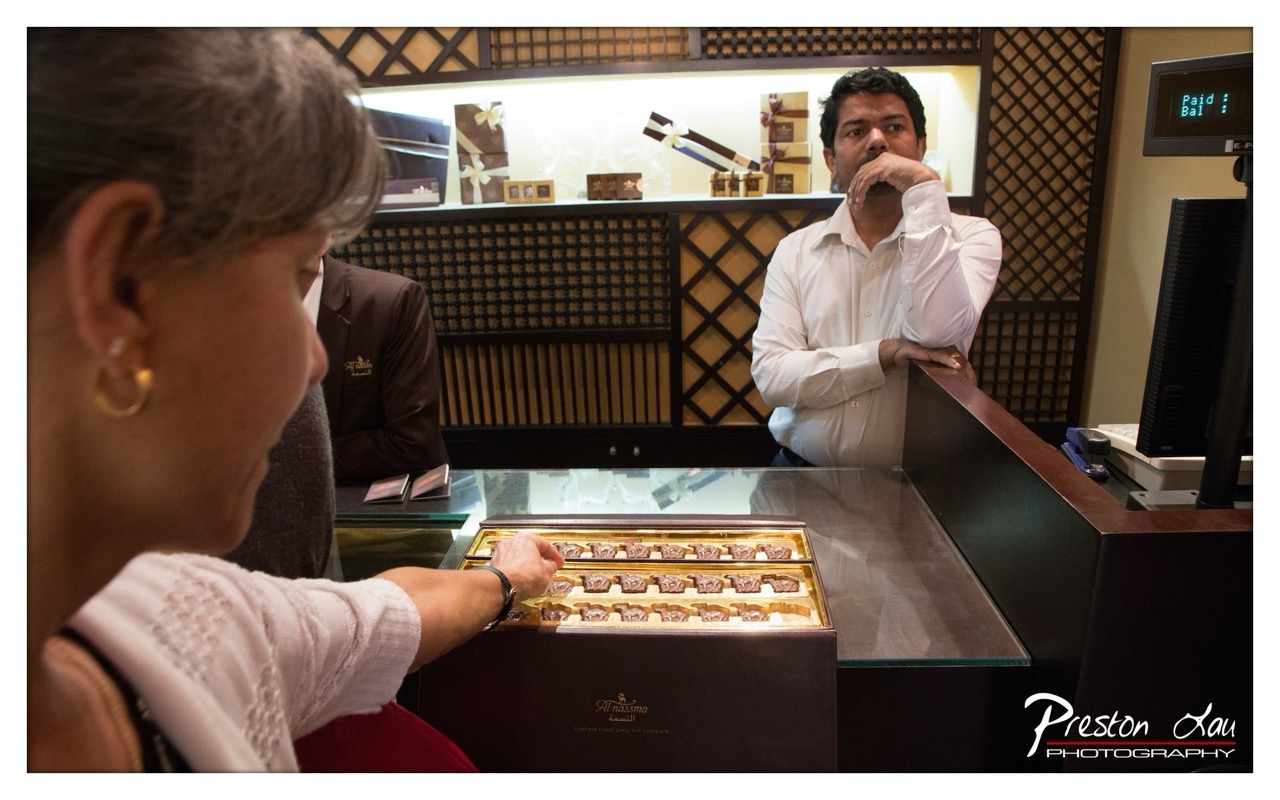

Title: Contemplating Cocoa Decisions
Rating: 7/10
This image captures a moment of sweet consideration within a chocolate shop. The main subject is the act of choosing chocolates from an elegant box, earning the scene a 7/10 for its universal appeal. A woman's hand reaches towards a tray of camel-shaped chocolates, suggesting this isn't just any chocolate, but perhaps something unique like camel-milk chocolate, identifiable by the Al Nassma logo on the box. Behind the counter, a staff member leans with a thoughtful expression, looking less like a salesperson and more like a philosopher contemplating the profound mysteries of confectionery. Another person in a brown jacket is partially visible in the background, adding to the shop's atmosphere. The mood feels focused and perhaps slightly luxurious, centered around the desirable contents of the box.
From a photographer's viewpoint, the composition uses the counter and the chocolate box as strong foreground elements. While the woman's head is cropped, her hand and arm effectively draw the eye to the box, creating a sense of active engagement. The staff member in the background provides depth and human context, his pensive pose adding an unexpected narrative layer. Lighting is warm and inviting, creating highlights on the chocolates and the polished counter surface. The color scheme leans towards rich browns, golds, and whites, creating a sense of quality and indulgence, fitting the subject matter. The background, with its decorative shelves holding neatly wrapped gift boxes, provides essential context about the location. The style is observational, capturing a natural moment, though the framing on the left is a little tight – perhaps the photographer was caught up in the deliciousness too!
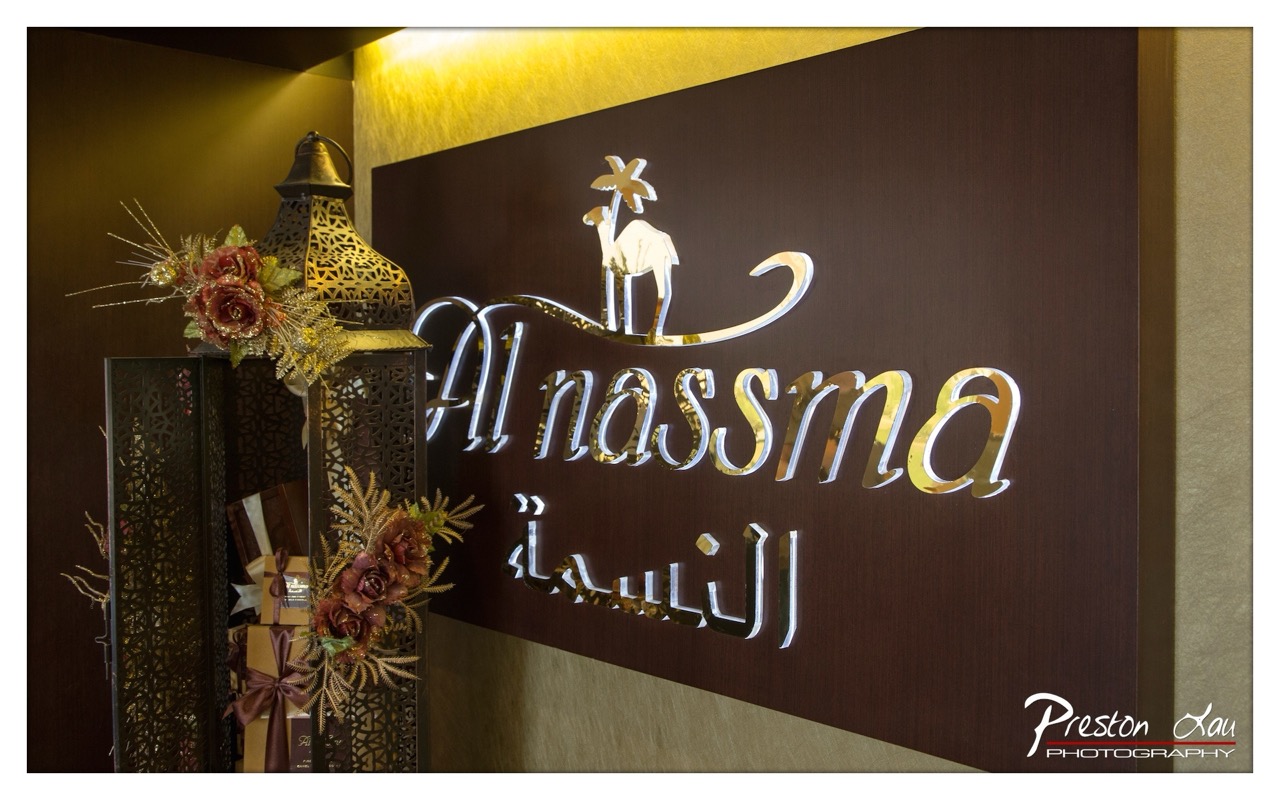

Al Nassma's Golden Oasis Display
Rating: 8.5/10
Behold, a vignette of desert luxury! This shot perfectly captures the essence of the Al Nassma brand, centered around a striking sign featuring shimmering gold lettering spelling out "Al nassma" in English and Arabic, topped with an iconic camel silhouette beneath a palm tree. Flanking this elegant display are intricately designed dark metal lanterns, their latticework hinting at Arabian nights, adorned with sophisticated arrangements of faux flowers in deep reds and golds. Below, a stack of beautifully wrapped gift boxes peeks out, tied with rich brown ribbons, promising delicious contents. The composition expertly balances the bold signage on the right with the decorative elements and gifts on the left, drawing the eye across the scene like a camel caravan on a journey of indulgence. The overall mood is one of refined elegance and exotic appeal, making you instantly crave whatever delights lie within those enticing packages. It's a visual invitation to a world of premium treats.
From a photographer's perspective, this is a well-executed commercial shot designed to sell the brand's identity. The lighting is particularly effective; a warm light spills down from above, catching the gold letters on the sign and making them pop against the dark background, creating a lovely glow. The light on the lanterns and gifts is softer but still detailed enough to showcase their textures and wrapping. The rich brown tones of the sign and gifts pair beautifully with the gold accents and the textured beige background wall, creating a harmonious and luxurious color palette. The depth of field is just right, keeping the sign sharp while slightly softening the foreground elements, giving a sense of dimension without distracting from the main subject. While the angle is good, maybe a tiny shift could have avoided the slight cutoff of the leftmost lantern edge, but that's a minor quibble in an otherwise polished and inviting product display shot. Preston Lau Photography certainly knows how to make a camel look fancy.
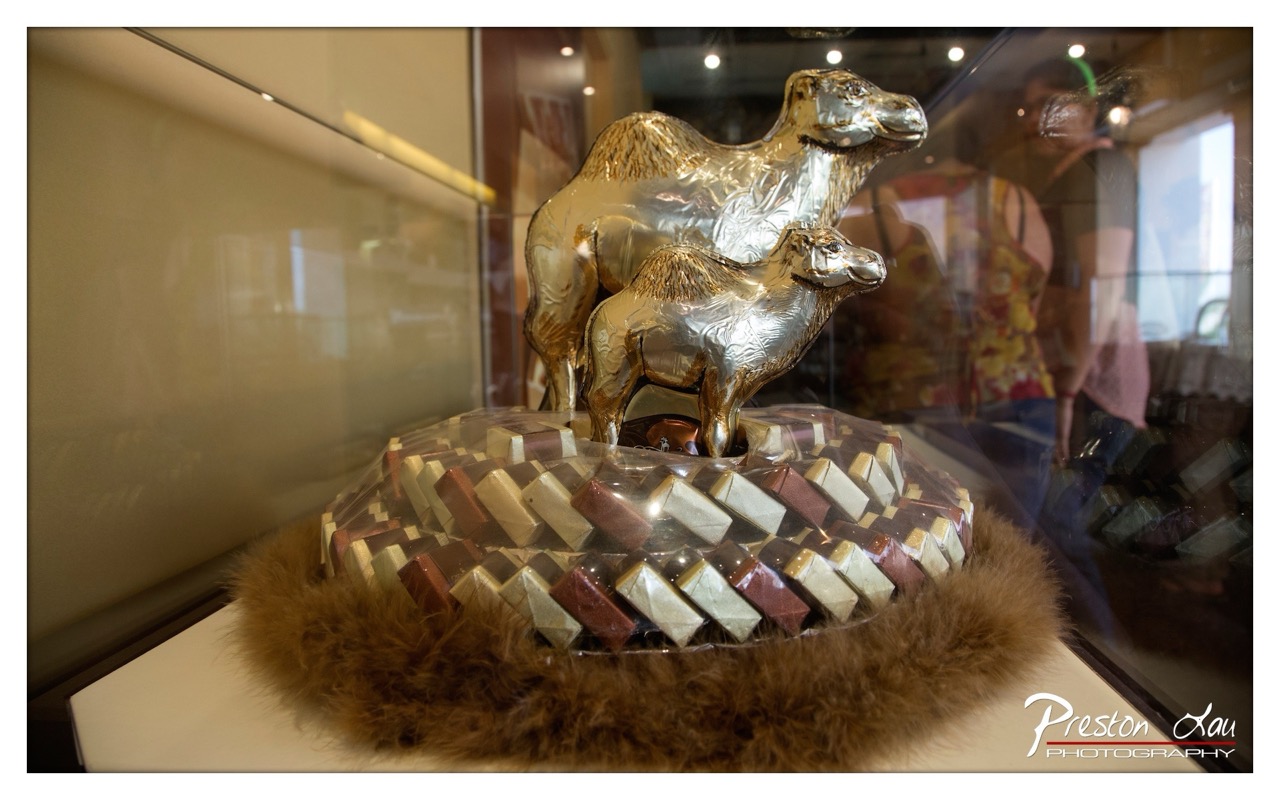

The Golden Guardians of the Chocolate Treasure
Rating: 7/10
This image presents a truly unique subject: a pair of shimmering, gold-colored camels standing proudly atop a mountain of individually wrapped chocolates, all nestled within a faux-fur trim base and encased in glass. It looks like the ultimate gift for someone who appreciates both desert animals and a sugar rush, perhaps presented in a luxury shop or as a very extravagant corporate award. The mood is certainly one of opulent (or possibly slightly kitsch) indulgence, a testament to combining unexpected elements in pursuit of perceived grandeur. The larger camel standing behind the smaller one adds a familial or protective dynamic, making them look like proud parents overseeing their delicious, edible kingdom.
From a photographic perspective, this shot tackles the perennial challenge of shooting through glass. The lighting, likely overhead or within the display case, beautifully highlights the metallic finish of the camels and the wrappers, bringing out their gleam, though it also introduces distracting reflections, including a rather clear reflection of a person's torso wearing a floral top – an unavoidable element when working with reflective surfaces in a busy environment. The composition, centered on the camels and their base, feels a bit static, but the low angle does help emphasize the 'monumental' nature of this sugary sculpture. The blend of gold, brown, and the surprising touch of faux fur creates a distinct color palette that the photographer has captured effectively, despite the technical difficulties imposed by the display case. Capturing such a bizarre yet eye-catching subject required navigating tricky lighting and reflections, making it a decent effort to document this peculiar confectionary display.
Loading map...